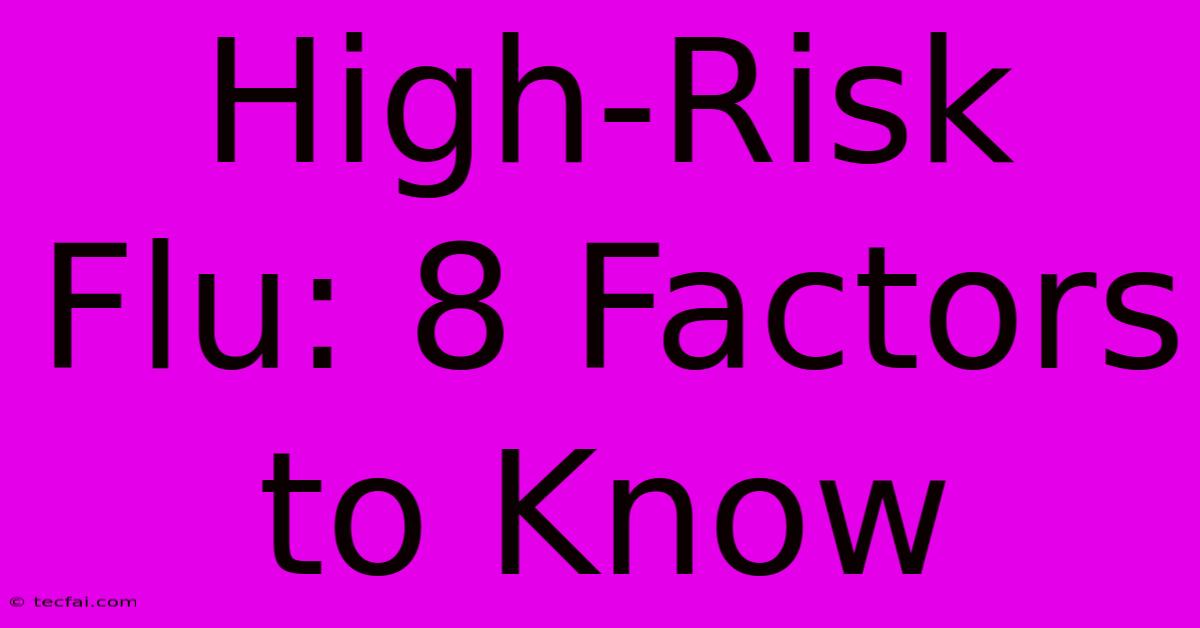High-Risk Flu: 8 Factors To Know

Discover more detailed and exciting information on our website. Click the link below to start your adventure: Visit Best Website tecfai.com. Don't miss out!
Table of Contents
High-Risk Flu: 8 Factors to Know
Influenza, commonly known as the flu, is a viral infection that can range from a mild inconvenience to a severe, even life-threatening illness. While most healthy individuals recover within a week or two, certain factors significantly increase the risk of developing serious complications. Understanding these high-risk factors is crucial for proactive prevention and management of the flu. This article will delve into eight key factors that elevate your risk of experiencing a high-risk flu season.
8 Factors Increasing Your Flu Risk
It's important to remember that these factors are not mutually exclusive; you might have several of them increasing your risk exponentially.
1. Age: The Young and the Old
Both very young children (under 5 years old) and older adults (over 65 years old) are particularly vulnerable to severe flu complications. Their immune systems may be less robust, making them less able to fight off the virus effectively. Infants, especially those under 6 months, lack the developed immune response to even receive the flu vaccine.
2. Underlying Health Conditions: A Weakened Defense
Individuals with chronic health conditions like asthma, heart disease, kidney disease, diabetes, lung disease, neurological conditions, or weakened immune systems (due to HIV/AIDS, cancer treatment, or organ transplantation) are at a much higher risk of severe flu. The virus can exacerbate these pre-existing conditions, leading to significant health problems.
3. Pregnancy: A Vulnerable State
Pregnancy significantly alters the body's immune system, making pregnant women more susceptible to severe flu complications, including pneumonia and hospitalization. The flu can also pose risks to the developing fetus.
4. Obesity: Increased Susceptibility
Obesity is increasingly recognized as a risk factor for severe flu. Excess weight can impair lung function and immune response, making individuals more vulnerable to complications.
5. Native American and Alaska Native Ancestry: Disparities in Health Outcomes
Studies show that individuals of Native American and Alaska Native descent experience disproportionately higher rates of severe influenza complications. This disparity highlights the importance of targeted public health initiatives and increased access to healthcare within these communities.
6. Exposure to High-Risk Individuals: Contagion Risk
Close contact with individuals who are already infected with the flu significantly increases your risk. This emphasizes the importance of hand hygiene, covering coughs and sneezes, and staying home when sick.
7. Immunosuppressant Medications: Compromised Immunity
Individuals taking immunosuppressant medications, often prescribed for autoimmune diseases or after organ transplants, have compromised immune systems, rendering them highly vulnerable to severe flu.
8. Lack of Vaccination: Preventive Measure
Annual influenza vaccination remains the most effective way to protect against the flu and its potentially severe complications. While the vaccine doesn't guarantee complete protection, it significantly reduces the risk of hospitalization and death.
Protecting Yourself During Flu Season
Understanding these high-risk factors empowers you to take proactive measures to protect your health. Beyond vaccination, practicing good hygiene, such as frequent handwashing, and avoiding close contact with sick individuals are crucial preventative steps. If you experience flu-like symptoms, consult your doctor promptly, especially if you fall into one of the high-risk categories. Early diagnosis and treatment can significantly improve outcomes.
Remember, staying informed and taking preventative steps is key to navigating flu season safely. Consulting your physician regarding your personal risk factors and vaccination needs is always recommended.

Thank you for visiting our website wich cover about High-Risk Flu: 8 Factors To Know. We hope the information provided has been useful to you. Feel free to contact us if you have any questions or need further assistance. See you next time and dont miss to bookmark.
Featured Posts
-
Dobbins Injury Chargers Scoring Slump
Nov 26, 2024
-
The Adults End Of Life Bill 2024 25
Nov 26, 2024
-
Brazil Police Arrest Officers In Coup Plot
Nov 26, 2024
-
Jon Benet Ramsey Netflixs Heartbreak
Nov 26, 2024
-
Ramsey Documentary Director Unveiled
Nov 26, 2024
